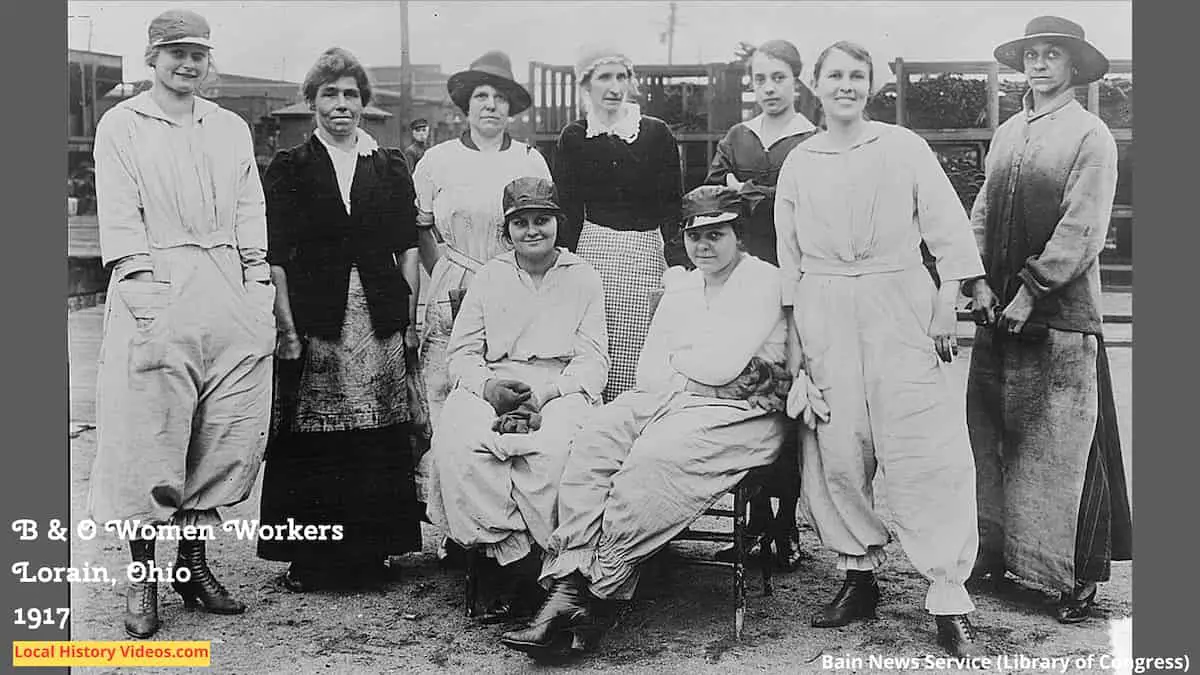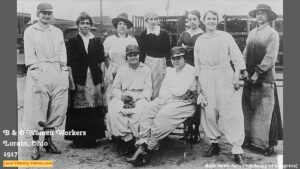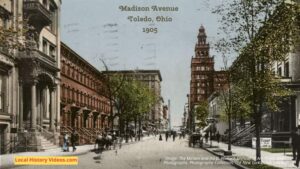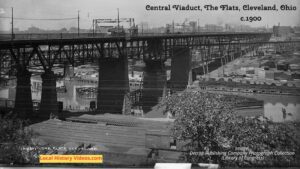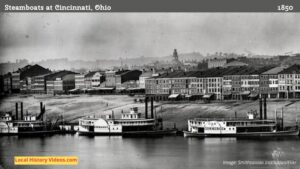Glimpse history through old images of Lorain, Ohio, USA.
Old Photo of Broadway, Lorain
An old photo taken sometime around the turn of the 20th Century shows horses and carts along Broadway, with telegraph poles high above the pedestrians.
I’ve added three closeups so you can see more detail of the shops and people.

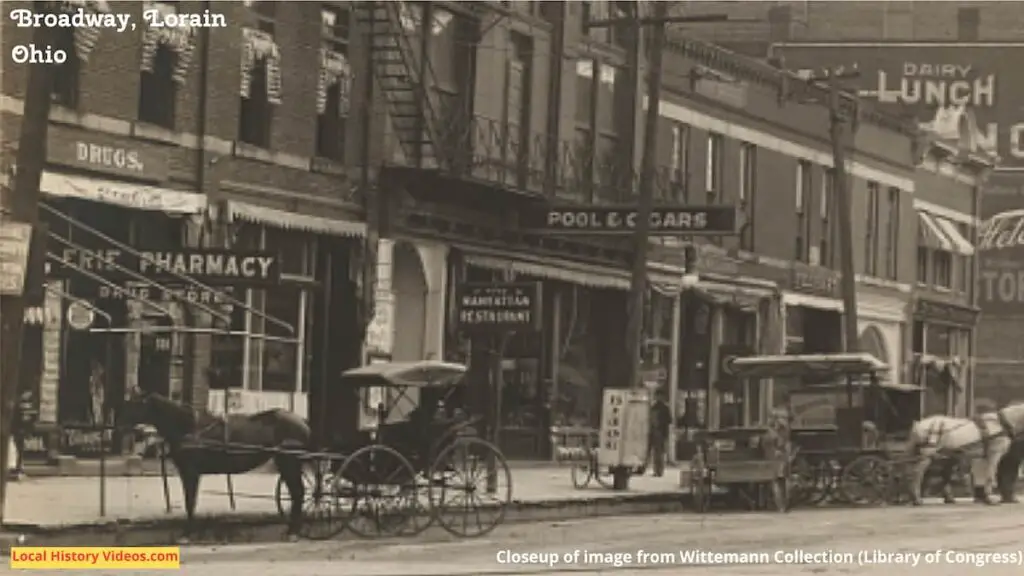
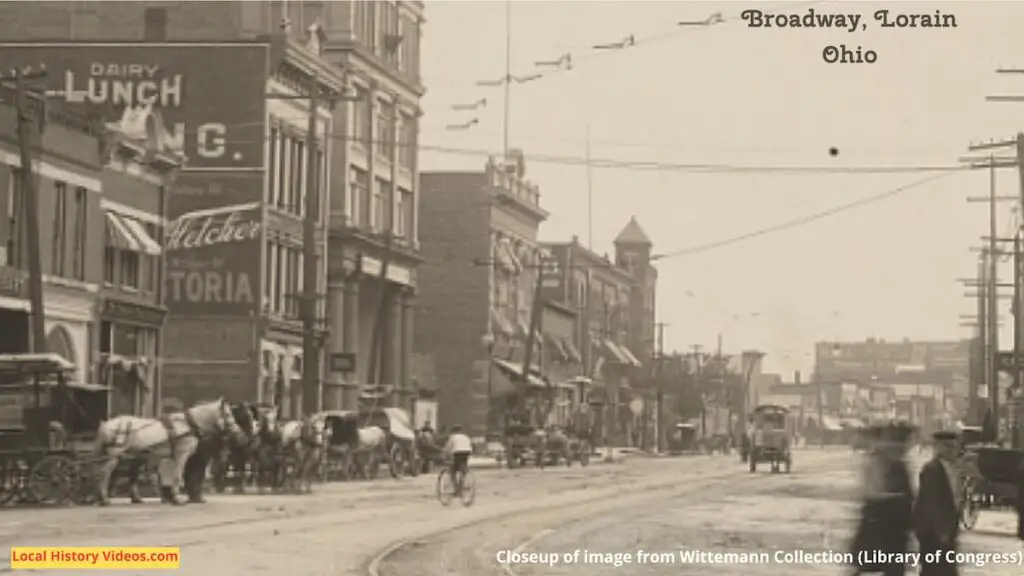
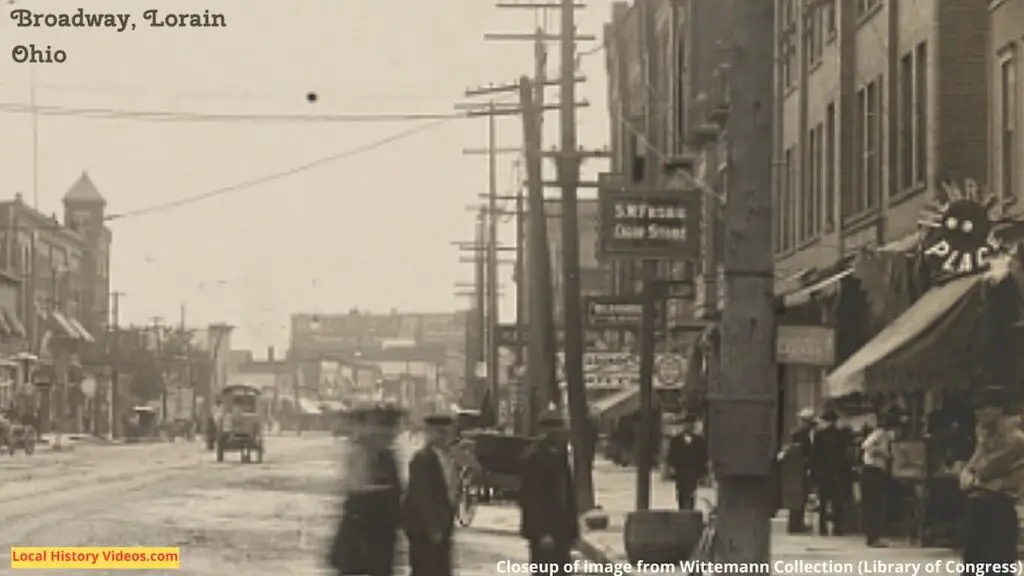
Tornado Damage 1924
A compilation of images showing the tornado damage experienced in the area in 1924 can be seen in more detail at the Library of Congress website.
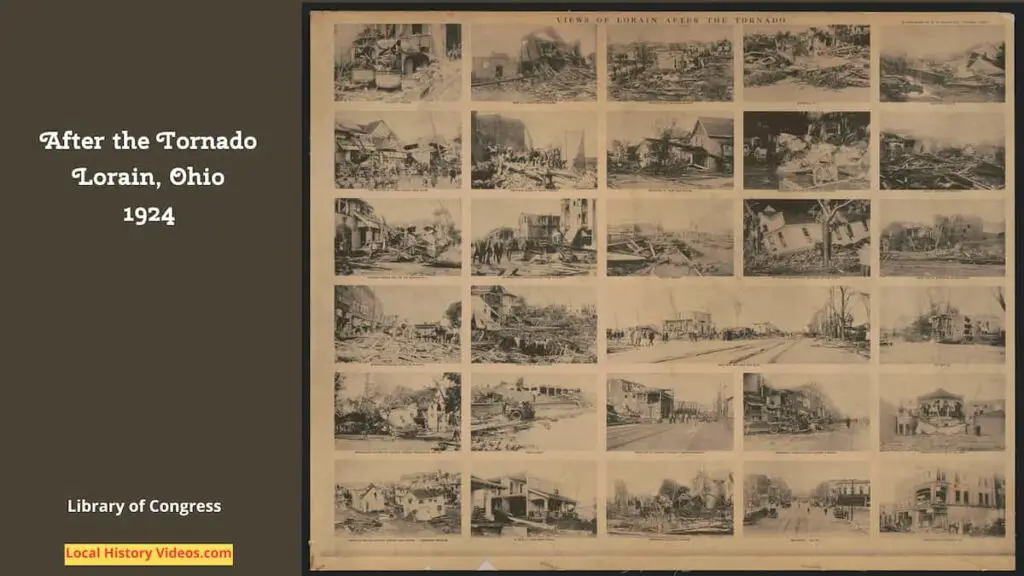
Old History Book
Extract from:
History of Lorain County, Ohio
by Williams Brothers of Philadelphia
Published in 1879
Pages 207 – 212
BLACK RIVER
By the survey of 1806, Black River (town number seven in the eighteenth range) was divided into three parts gore number one, tract number two, and gore number three. It was not drawn as a township, but was used for equalizing purposes, gore one being annexed to Olmsted, tract two to Amherst, and gore three to the township of Medina, and the original proprietors of those townships became the owners of the soil of Black River.
SURFACE, STREAMS, TIMBER.
The surface of the township is remarkably even, sloping gradually to the lake, with a deep, dark, generally loamy clay soil of exceeding fertility. The water courses of the township are Black River, Beaver Creek, and Martin’s Run. All of which lave their outlets in the lake. Black River divides a small part of the township in the northeast corner from the rest of its territory and affords excellent advantages for the utilization of water power. Beaver Creek drains the western part of town, while Martin’s Run courses through the center.
On the lake shore, the native kinds of timber were chiefly hickory, white oak, elm, and basswood. While farther inland, the principal variety was white oak.
SETTLEMENT.
In regard to an early attempt at settlement, Judge Boynton says, in his “Early History of Lorain county:”
“The earliest attempted settlement was at the mouth of Black River.
In 1787, a few Moravian ministers, missionaries among the Delawares and other tribes, with a band of christian Indians, undertook to make a permanent settlement at that point. In the spring of that year they removed from Pilgrim’s Rest, on the Cuyahoga, to the place contemplated as their new aboule. Here they hoped to establish a center and plant the seeds of the christian civilization of the Indians. Their hopes, however, were not to be realized. They had remained but a few days upon the spot selected, when a message from the chief of the Delawares, commanding them to depart from Black river was received and at once obered. This was the first settlement in what is now the county: for although temporary and of but short duration, it in fact coupled with an intent to remain.”
In 1807, Nathan Perry came to the mouth of Black river and erected a house a short distance east of the river, in which he opened a store for trade with the Indians. He had in his employ Azariah Beebe and wife, who occupied his house. They were the first family that settled in the township. They remained only a few years, however, when they removed from the township, settling on Huron river, where they both died a few years after. Perry, after a few years, removed to Cleveland, where he engaged in merchandizing, continuing his trade with the Indians, and eventually amassed a large property.
He was a son of Judge Nathan Perry, of Ratland, Vermont, who was an early settler in Cleveland. He was a man of more than ordinary ability. His son Horace was for many years clerk of the court of common pleas of Cuyahoga county. Horatio, another son, settled first in Vermillion and afterwards in Elyria.
Judge Perry’s only daughter was the wife of Peter Weddell, of Cleveland, who built the Weddell house of that city.
Daniel Perry, a brother of the judge, was the next permanent settler in the township. He, with his family, arrived in March, 1810, and located a quarter of a mile west of the river. He afterwards removed to his nephew’s farm east of the river, still retaining the farm on which he first settled. Squire Perry, as he was familiarly called, with his large family, had an uphill life of it in Black River, and to better his condition, removed in an early day to Brownhelm, and settled near the center of the town. He lived to a good old age, and reared a large family of children, some of whom are now living in Brownhelm quite advanced in life.
This same year the families of Joseph Quigley, Jonathan Seeley, George and Andrew Kelso and Ralph Lyon were added. Quigley, at an early date, removed to number six, range eighteen, Amherst. He lived to the great age of ninety-four or ninty-five years.
Seeley located on lot twenty-one. Of his subsequent history, as well as that of some others mentioned, nothing is known.
Ralph Lyon and family, then consisting of his wife and two children, came to Black River from Beaver county, Pennsylvania, in the fall of 1810. He located about two miles west of the river on the lake shore, on the farm now owned by Alanson Gillmore, lot twenty. After a short stay here, he removed to Beaver creek, purchasing the farm now occupied by H. Kolb. This he afterwards sold, and he then moved to the mouth of Black river, where he died at the home of his son-in-law, Nathan Edson, in January, 1832. His wife died a few months afterward. Their family consisted of six children, all now dead. A son, John, was born in the spring of 1812, and was the first white child born in the territory comprised within the present limits of Black river. A daughter, Catharine, married the well known Captain William Joues, of Lorain. She died in October, 1875.
The next family that settled in Black River was that of John S. Reid. Mr. Reid, who was a native of New Jersey, was residing in the vicinity of Cleveland at the time of his removal to this township. He and his daughter Elizabeth came to the mouth of Black river in the spring of 1810. His first erection stood nearly opposite the present site of the large frame building, at the foot of Elyria street, now owned by Artemas Beebe, of Elyria, which was also built by Reid. His original cabin was a double block house, a stately structure for the time, and was used for many years by Mr. Reid as a dwelling, tavern, post-office and justice’s office combined. In the spring of 1811, the rest of the family arrived. This family formed the center around which a little settlement at the mouth of the river gathered, and which soon came to be known by the name of “Black River.”
Mr. Reid was a man of strong points of character, and naturally exercised considerable local influence. In 1819, when this township was embraced in the county of Huron, he was one of the commissioners of that county, and in 1824 was one of the first three commissioners of Lorain county. He was also postmaster and justice of the peace for many years. He died in December, 1831, and Mrs. Reid in March, 1832. A son, Conrad, is still a resident of Black River, having resided at the mouth of the river for sixty-seven consecutive years. Cornelius, an older son, was drowned on the lake, in November, 1818. His father engaged a Captain Brooks, with his vessel, to take a load of corn, in the ear, to Detroit, and Cornelius was sent in charge of the cargo. Two other men were also aboard. When off Huron, a terrible gale capsized the vessel, and all on board were lost. The names of the other children were Sophia, Elizabeth, and Ann. The first two became, respectively, the wives of Daniel T. Baldwin and Quartus Gillimore. Before we take leave of Mr. Reid, we will relate an anecdote which we have not before seen in print.
In the early settlement of the country, the “extract of corn” was a universal beverage, taken, of course, to “keep off fever.” No well-ordered public house, especially, could get along without it, and the liquid was always within easy access of the guests, who were expected to help themselves at will. On one occasion, Dr. of Conneaut, stopped overnight with Reid. The next morning, when he came to settle his bill, he found among the items charged that of whiskey. The doctor assured his host that he had used no liquor, and demanded a consequent reduction in the amount of the bill. “It doesn’t make any difference,” replied Reid, “whether you used it or not, the whisky was before you, and it is your own fault if you didn’t have it.” The doctor paid the bill and departed. Some months afterwards he stopped with Reid again, who, on presenting his bill, was confronted with one for a like amount by the doctor, for medicine. “What do you mean?” said Reid, “I have had no medicine.” “That doesn’t matter,” retorted the doctor, “it was in my medicine bag, and it was your own fault if you didn’t.” Reid thought the cases sufficiently parallel to give the doctor a free night’s lodging.
William Martin, a native of Pennsylvania, with his family of wife and six children, joined the settlement in April, 1811, performing the journey with an ox team and wagon. Martin exchanged his farm of three hundred acres in Pennsylvania, for nearly a thousand acres in Black River and Amherst, most of it in the latter township. He took up his residence on lot twenty-one, moving in a house erected the year previous by Jonathan Seeley. For some unknown cause, he never obtained a title to any of his western land, except that comprised in lot twenty-one, in this township.
Martin came to an untimely death, in October, 1830, by a singular accident. He had just come out of a well, which he with others was sinking on the farm of Nathan Edson, on the Oberlin rows, when Edson took hold of him to engage in a friendly scuffle, the result of which was that Martin fell into the well, twenty feet deep, killing him almost instantly. His widow died in 1842. There were eight children in this family, two born subsequent to the settlement in Black River. The only surviving member of the family is Mrs. Sleator, who resides on the old homestead, nearly eighty-one years of age. A son, Robert, died by accident, on a steamboat, at Perrysburg, Ohio, in 1832.
Next in order is Edmund Gillmore, who came to Black River from Chester, Hampshire county, Massachusetts, in 1811. He was accompanied by his son, Aretus, and a nephew, Ashbel Gillmore, and his family. He selected a location on lot twenty-two, erected a house, and leaving Aretus in charge, returned to Massachusetts for the residue of his family, with whom he arrived in June of the following year. Ashbel Gillmore not liking the level, wet lands of Black River, had been conveyed by his uncle to the hills of Geauga county, where he found in the township of Chester, in that county, a location more to his taste.
Quartus Gillmore, another son of Edmund, with a cousin, (brother of Ashbel,) preceded the family, making the entire journey on foot, the latter joining his brother in Geauga county.
Mr. Gillmore, senior, built the first frame barn in the county. He was a large owner of land, having, at one time, nearly a thousand acres, most of it in this and Amherst townships. He had a family of nine children, three of whom are yet living,-Truman, Alanson, and Edmund,-the first two in Black River, aged respectively eighty and seventy-four. Edmund resides in Minnesota.
Quartus, at the age of thirty-four, married Mrs. Elizabeth Smith, nee Elizabeth Reid, daughter of John S. Reid. She married, at the age of sixteen, William Smith, of Black River, who died four years after the marriage. After six years of widowhood, Mrs. Smith married Mr. Gillmore. Mr. and Mrs. Gillmore lived to a hale old age, and reared a large family of children, all of whom are living, and one of whom— Quincy A.-rose to fame and honors in the war of the rebellion. Major General Gillmore resides in New York City, and has charge of the military defences between that city and Florida. The other children are Elizabeth, now Mrs. William Prince, of Cleveland; Sophia, wife of Daniel S. Leslie, residing in Northport, Michigan; Roxana, widow, in California Edmund, Alice (Mrs. James Connolly), Quartus and Cornelius, are all residents of Black River. Edmund, many years since, met with an accident by which he was made a cripple for life. While engaged in calking the scow, Couiin Mary, in 1860, it became necessary for him, in the prosecution of his work, to get under the center board, which partially settled upon him. He was quickly released from his perilous situation, but it was found that his lower limbs were paralyzed, and he has been unable ever since to use them. He is at present performing the double service of township clerk and justice of the peace.
No other additions were made to the settlement until after the close of the war, which almost completely arrested emigration. Among the later arrivals was the family of Captain Augustus Jones. He was
originally from Middlesex county, Connecticnt; was by trade a shipwright, and became a captain of a vessel on the Atlantic. He came to Black River in company with a brother of his wife, Enoch Murdock, in the spring of 1818. He immediately commenced work for Captain James Day, who was then building the General Huntington-Murdock returning to Connecticut. In the fall of the same year, the family of Captain Jones, wife and five children, followed. They were brought by Elisha Murdock, another brother of Mrs. Jones, to Buffalo, where they took passage for Cleveland on the boat FriendshipMurdock, with his horse and wagon, continuing the land journey alone. Captain Jones met his family at Cleveland, and brought them to Black River. He and Murdock, who was a single man, made a joint purchase on lot twenty-one. Captain Jones soon after sold his interest to Murdock, and purchased on lot one, where he made a permanent location and cleared up a farm. He afterwards engaged almost exclusively in vessel building, and the Jones family have acquired an extensive reputation in this line. Perhaps no other one family in the nation have built so many vessels as Captain Jones and his five sons. He died in 1842—Mrs. Jones previously. Their children, of whom there were seven-five sons and two daughters
-are all living but one. William, seventy-two years of age, younger in appearance by many years,-resides in Lorain, retired from active business, except to look after his vessel interests, which are by no means small. George W. lives in Cleveland, and is a captain on the lake. Frederick, in Buffalo, and J. M., in Detroit, are both engaged in ship building. Buel B., deceased, lived in Milwaukee. Maria lives in Kansas, and Antoinette in Cleveland.
Captain James Day, of whom mention has been made, was also a Connecticut man, and came to Black River in the fall of 1817. Samuel Gilbert, E. Crawford, Jesse Cutler, John Morrill, John Pollard and Amos Perry also came about this time. The first three located in the southeast part of the town, and several years after removed from the State. The others located on the lake shore.
Daniel T. Baldwin of Berkshire county, Massachusetts, came to Ohio at an early date. He subsequently married a daughter (Sophia) of John S. Reid, and settled in Black River, west of the river, on the farm known as the Brownell farm. Baldwin was a man of superior ability and of some prominence. He was elected to the State legislature in the fall of 1834, being chosen by a majority of thirty-four votes over his democratic opponent, E. W. Hubbard of La Grange. He was also associate judge for this county. He died in 1847.
Thomas H. Cobb and other unmarried men whose names cannot be remembered, joined the settlement. at an early date.
Captain Judah W. Ransom came in the year 1819. He was a sailor-farmer, spending his summers on the lake and his winters on the farm, east of the river, known as the E. Gregg farm. He made extensive improvements on this place, building a barn which, Mr. Root says, “took all the men within the circuit of ten miles to raise,” the force even then being unable to complete the work in one day. This barn is yet standing, though not on its original site.
After a residence of a few years in Black River, Ransom removed with his family to Sandusky. His death occurred in 1840, when he and all the rest of the crew of the “Helen Man” were drowned.
Two Irishmen by the name of Ray settled on Beaver creek at an early date.
Thomas Brown, who has been a resident of Lorain county nearly half a century, came to the mouth of Black river from Detroit in 1829, and opened a tailor shop there. He married Ann Smith, daughter of William and Elizabeth Smith, (who was the daughter of John S. Reid) and continued his residence in Black River for twenty-two years. Mr. Brown subsequently engaged in the business of hotel keeping, and was the proprietor of the American House in Elyria for many years. He has now (1878) charge of the Park House in Oberlin. The father of Mrs. Brown, (William Smith), settled in Black River at an early date, and a son, Lester Smith, now resides there.
As to later settlers, Mr. W. H. Root writes: “Up to the year 1830 little or no settlement was made in this township away from the lake road, and but few in the southeast corner of the town. The unsettled portion was a dense wilderness, covered principally with white oak timber, when the sturdy Germans began its settlement in the year 1833. They did not all come in one month or one year, but their numbers increased rapidly, and wherever they went they made their mark, which mark is plain to be seen at the present time. I will name a few of these pioneers as I remember them and am able to write out their names: C. L. Faber, Baunhaets, Jacobs, Friends, Barks, Haulsaure, Hagerman, Hauns, Vetter, Harwick, and others.”
ORGANIZATION.
At the organization of Dover, Cuyahoga county, in 1811, that township included the territory of Black River east of the river. In March following, that part of Black River west of the river was also annexed to Dover. The union thus continued until Vermillion was organized when the latter annexation was changed to that township; and in October, 1818, on the organization of the township of Troy, Black River east of the river, constituted a part of that township. In 1817 the commissioners of Huron county, whose eastern boundary extended for a distance east of Black River, ordered, “that township, number six (Amherst) and that part of number seven (Black River) in the eighteenth range, which lay in the county of Huron, with all the lands thereto attached in said Huron county, be set off from the township of Vermillion and organized into a separate township by the name of Black River. Thus Amherst, Black River
and Brownhelm were first organized as Black River.” In June, 1824, the corner of the town east of the river was annexed to Black River for judicial purposes.
The first election for township officers was held at the house of John S. Reid, April 17, 1817. John S. Reid was called to the chair, and Chilial Smith and Edmund Gillmore appointed judges of election. Township officers were elected as follows: Daniel Perry, clerk; Adoniram Webb, Quartus Gillmore and Joseph Quigley, trustees; Chilial Smith and Edmund Gillmore, overseers of the poor; George Kelso and Stephen Cable, fence viewers; Orrin Gillmore and James Webster, appraisers of property; William Martin, Ralph Lyons, Chilial Smith and Reuben Webb, supervisors of highways; John S. Reid, treasurer. At the election in Black River, for State and county officers, October 14, 1817, there were cast, according to the poll list in the handwriting of Daniel Perry, clerk, seventeen votes, as follows: John S. Reid, Daniel T. Baldwin, Jacob Shupe, Joseph Quigley, Quartus Gillmore, A. Webb, Reuben Webb, S. Cable, Daniel Perry, John Morrell, Chilial Smith, Fred Onstine, Daniel Samuel Cable, Henry Onstine, James O’Neal, George Kelso.
The relation as formed in 1817, continued until October, 1818, when Brownhelm was detached and incorporated as an independent township. Russia was detached in June, 1825, leaving the territory now embraced in the township of Amherst and Black River forming one township. These two towns continued as one until January 12, 1830, when by a special act of the legislature, they were divided. “There was an act in force that inhibited the incorporation of any township, by the act of the county commissioners, with less than twenty-two square miles, unless it included a town corporate; and this inhibition prevented the organization of Black River, with its present limits, by the commissioners of the county. An application was therefore made to the legislature for a separate organization, and on the 12th of January, 1830, an act was passed incorporating the inhabitants of fractional township number seven, range eighteen, in the Connecticut Western Reserve, by the name of Black River. The act directed, that on the first Monday of April, then next, an election for township officers should be held at the house of John S. Reid, Esq., in manner and form as provided by law.”
The book containing the record of this election. was rescued by Edmund Gillmore, the present town clerk and justice of the peace, from a party of boys in Lorain, who were about to use it for a mark in their target practice. From it we find that, in pursuance of the act above referred to, a meeting of the electors of the township of Black River was held at the house of John S. Reid, on Monday, the 5th day of April, 1830. Quartus Gillmore, Samuel Gilbert and Barna Meeker were appointed judges, and Daniel T. Baldwin and John Myers, clerks of the election,
which resulted as follows: Daniel T. Baldwin, clerk; Quartus Gilmore, Samuel Gilbert and Barna Meeker, trustees; John S. Reid and Eleazer Crawford, overseers of the poor; John S. Reid and Eleazer Crawford, fence viewers; Morris Jackson, treasurer; John S. Reid, Thomas Wymans, George Kelso and Eleazer Crawford, supervisors of highways; Sidney Mitchell, constable. We find no election of a justice of the peace until the following year, April 4, 1831, when Quartus Gillmore was elected to that office.
The following named are the present incumbents of the respective township offices: Edmund Gillmore, clerk; W. H. Aiken, Elias Baumhart and Frederick Friend, trustees; Thomas Gawn, treasurer; P. B. Delany, assessor; Chas. Friend and John Aschenbach, constables; Edmund Gillmore and S. C. McMillen, justices of the peace.
There were originally two post offices in the town. One was located on the South ridge, now South Amherst, and called “The Black River Post Office.” The other was named “The Mouth of Black River Post Office,” and was kept at the mouth of the river. Eliphalet Redington was the first post master of the former office, and John S. Reid of the latter. Henry Chapman is the present incumbent of the Lorain post office.
SCHOOLS.
The first school in Black River was opened at an unascertainable date in an unoccupied log house of Edmund Gillmore. The teacher was David Smith, of Amherst. The first school house was erected not long after, on the farm of William Martin, the first school in which was taught by Lucia Smith, a sister of David. According to the report of the board of education for Black River for the year ending August 31, 1878, there are in the township outside of the village of Lorain, two school houses, valued, including the ground, at one thousand two hundred dollars; amount paid teachers, five hundred and seventy-four dollars; pupils enrolled, sixty-eight.
The initiatory steps in the erection of the handsome and commodious brick school building in Lorain, were taken at a special election held May 30, 1874, when it was voted almost unanimously to bond the village to the amount of fourteen thousand dollars, to be used substantially as follows: Two thousand dollars for the purchase of a site, ten thousand dollars for the building, and two thousand dollars for maintaining the schools the first year. The building was erected in 1874-5. The first principal of the schools in the new building was Miss Hattie Ayers. J. R. Rogers is at present occupying that position. There is also a frame school building, recently repaired. From the report above referred to we learn the following facts as to this, the “Lorain Union School District:” Number of school houses, two, which, with the grounds, are valued at thirteen thousand dollars; number of teachers employed, six; number of pupils, two hundred and sixty-five; amount paid
teachers, two thousand one hundred and eighty-seven dollars. The following named are the present members of the school board: E. C. Kinney, T. W. Fancher, S. A. Andrus, John Stang, H. Hageman, C. S. Vorwerk.
CHURCHES.
METHODIST EPISCOPAL CHURCH.
We experienced much difficulty in obtaining exact information concerning the history of this church, and regret that we cannot give it more complete.
The Methodist Episcopal Church of Lorain was organized in the spring of 1856, by the Revs. Hard and Griffin, and was the result of the remarkable revival meetings conducted by them the preceding winter. There were ninety-nine persons who united at the time of organization. In 1864, during the pastorate of Rev. G. A. Hughes, there were forty additions made to the membership. The present membership is something over one hundred. The present pastor is Rev. Uri Richards, resident at Berea. G. I. Baldwin is superintendent of the Sabbath school, which is large and prosperous.
The church building was erected in 1872, costing three thousand dollars. A parsonage is at the present writing in course of erection, to cost when finished about one thousand dollars.
EVANGELICAL CHURCH.
There was an organization of this denomination many years ago, in the northwest part of the township. The society built a meeting house on the farm of George Drudy. The church was subsequently disbanded and the meeting house sold, most of the members uniting with a similar society at North Amherst. The rest of the members continued their meetings, usually holding them at the log house of widow Brown, in Lorain, and in a few years organized the present church, and erected a building which cost six or seven hundred dollars. The members were Jacob Vedder and wife, Mrs. Mary Brown, son and daughter (John and Elizabeth), and a few others whose names cannot now be recalled. The church now numbers about forty members. Rev. Jacob Hunniker is pastor, and Henry Wiegand and John Horn, class leaders. The Sabbath school numbers. about one hundred pupils, with H. Wiegand, superintendent.
CONGREGATIONAL CHURCH.
For the facts in the following statement, we are indebted to Rev. J. B. Stocking, a former pastor of the church:
The Congregational church of Lorain, was organized July 23, 1872, by a council called for the purpose, with Rev. Samuel Wolcott, D. D., as moderator. The following churches were represented in the council: Oberlin First, Oberlin Second, Amherst, and Ridgeville. For some time previous to the calling of the council, there had been a growing feeling…
Page 213
THE VILLAGE.
Although the village of Lorain is of comparatively recent growth, its antecedent history dates back to an early period. About the year 1830, the mouth of Black river began to assume importance as a point for the shipment of grain to the east by the lake. This was before the era of railroads and canals in Ohio, and the harbor of Black river became the outlet for the cereals of a large section of country, the grain being hauled in wagons from as far away as Medina county. This of itself produced no little activity, and the little settlement known as Black River soon began to assume the semblance of a village, and, although “Charleston,” under which name the village was subsequently incorporated, is now chiefly remembered as only a happy illustration of the glorious uncertainty of land speculation, an account of its “rise and fall” may properly have a place in the history of this township.
The Ohio Railroad was surveyed in the year 1832, the first attempt at railroad building ever made in the State, and the route as surveyed led through the village. The following year work was begun on the Ohio canal, whose terminus, it was confidently expected, would be at this point. The expected early completion of these two great commercial enterprises gave a great impetus to the activity of the place, and especially as to the price of real estate. A part of the John S. Reid farm, at the mouth of the river, was surveyed and laid off into lots in 1834, by Edward Durand, and soon afterwards land for a considerable distance around the Center was held as high as a thousand dollars an acre, while village lots were almost beyond reach. For some inscrutable reason the canal went to Cleveland, and, while this was felt as a loss, it was not of sufficient importance to chill the ardor of the people of Black River as to the future greatness of their village. With land adjacent to town at a thousand dollars per acre and village lots beyond the possession of all of ordinary resources, its destiny was fixed, and the failure to secure a canal was a matter of minor importance; besides, the railroad was sure, work upon which was afterwards, in 1837, actually begun.
The mania for land speculation which had seized the citizens of Black River is thus described by a writer* (N. B. Gates in Elyria Republican) then on the spot:
“In early spring, 1836, State Engineer Dodge, with his corps of assistants, came in from Coshocton, via. Wooster, surveying what was termed the Kilbuck and Black River Canal. As the engineers came down real estate went up. About this time Dr. Samuel Strong put in an appearance. His first purchase of real estate was some five acres of land taken from the farm of Conrad Reid, adjoining the village plat of Black River. This was mapped out on paper, with streets, lanes, etc., and sales commenced. Every person in Black River that could write, and had any leisure time, was set to writing out articles of agreement for the doctor and his purchasers. The five acres were soon exhausted and the doctor bought six acres from the same farm, adjoining the five acres. All the Black River clerical force was again employed writing land contracts. About this time the great patroon, H. C. Stevens, put in his appearance and gobbled up all that was left, that was for sale. He purchased the residue of the Conrad Reid farm, entering into contract to pay for the same seventy-five thousand dollars. He also purchased of Quartus Gillmore a one-third interest in the original plat of Black River for a liberal sum. We all dabbled in city lots more or less, and nearly every body in Black River, and a good many in Elyria got rich-on paper-in a very short time H. C. Stevens claimed to be worth half a million-in fact we were all rich.”
In 1835 the following were the principal business men of Black River: William Jones, merchant; Gates & Green, general merchandise; Delos Phelon and O. Root, forwarding and commission merchants; Daniel T. Baldwin, farmer; Barna Meeker, proprietor of the old Reid House; A. T. Jones, blacksmith; E. Miller, shoemaker; Thomas Brown, tailor; W. E. Fitch, stave dealer; Quartus Gillmore, farmer and justice of the peace; Conrad Reid, postmaster.
In 1836 the village was honored by the legislature. with a corporation charter by the name of Charleston, and in the spring of 1837 the first and only charter election under that name was held. We are unable to give the names of the officers chosen, who, for some unknown reason, never entered upon their official duties.
The Ohio railroad scheme resulted in an ignominious failure. The funds of the company, never burdensome, gave out, an appeal to the legislature for aid was denied, and the city of Charleston had to keep along with its old wagon trade, the importance of which had almost been lost sight of in the excitement over the projected great enterprise of previous mention.
Its monopoly of the grain business for this section of the State continued, and Charleston kept on growing until it reached a population of several hundred, with stores, grain warehouses, hotels, etc., and property was still held at a high figure. In 1851 its grain trade was seriously curtailed by the building of the Cleveland, Columbus and Cincinnati railroad. Then for the first time the village realized what it had lost in the failure of the Ohio railroad scheme. In 1853 the Cleveland and Toledo road was begun. Unable to offer pecuniary inducements for a lake shore route, Charleston saw in her adversity, only eight miles distant, Elyria with a railroad assured, wealth and many natural advantages, starting off in a manner indicative of a prosperous future. Its fall is thus referred to by Major Hammond, in the Black River Commercial:
“It died without a struggle. Its hotels were practically closed; its merchants departed; its warehouses were almost given away to farmers for barns and fences, and even its corporate organization was abandoned; its name blotted out by common consent, and its memory placed in the catagory of western paper-city failures.”
Some of the owners of property were unwilling to thus ingloriously and ruinously end the struggle, begun under circumstances so favorable, and strenuous efforts were made to revive the place; notably by H. R. Penfield, who, at almost his own expense, had a survey made from Rocky river to Vermillion, through Black River (as the place again came to be called) for the proposed Cleveland, Port Clinton and Toledo. railroad, but capitalists could not be induced to foster the scheme. S. O. Edison, also a large owner of land, established a charcoal furnace and built a saw mill on the river nearly a mile from its mouth. The furnace was afterwards burnt down. It was not, however, until the commencement of the Lake Shore and Tus-. carawas Valley railroad that the place began to show signs of returning life. When the point was reached that the early completion of the road was no longer a matter of speculation, a remarkable revival of activity immediately began, and since that time the growth of the place has been steady and constant, until it now has, according to a recent school census, a population numbering fifteen hundred and forty-five.
At the regular meeting of the county commissioners, in the latter part or January, 1874, that body unanimously granted to Black River a charter of incorporation, under the name of Charleston, but the authorities at Washington refused to give the town a post-office with that name, as there was one or more of a similar name in the State; and on request of the citizens, “Lorain” was substituted. The first election of the re-incorporated village was held the 6th of April, 1874, when the following named persons were chosen for the respective offices, viz: Conrad Reid, mayor; E. Gregg, treasurer; H. A. Fisher, clerk; E. C. Kinney, civil engineer; Quartus Gillmore, marshal; R. J. Cowley, street commissioner; E. Gillmore, Thomas Gawn, E. T. Peck, John Stang, James Porter and F. W. Edison, councilmen; R. O. Rockwood, M. D., A. Beatty, M. D., James Connelly, E. Swartwood, Wm. Cunningham and Beaver Brown, board of health. The village officers, elected in the spring of 1878, are as follows: T. W. Fancher, mayor; Otto Braun, clerk; John Stang, W. A. Jones, F. Hogan, Chas. B. Chapman, Adolph Braun and C. S. Vorwerk, councilmen; Alanson Bridge, marshal; and Beaver Brown, street commissioner.

